

Leveraging Your Book and Platform Strategically. Everybody is doing it.
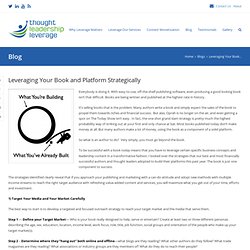
With easy-to-use, off-the-shelf publishing software, even producing a good looking book isn’t that difficult. Books are being written and published at the highest rate in history. It’s selling books that is the problem. Many authors write a book and simply expect the sales of the book to propel them towards riches and financial success. Meet Generation C: The Connected Customer. InShare976 Marketers, educators, parents, it seems that almost anyone in the Generation X or Boomer demographic is scratching their heads trying to figure out Generation Y aka the Millennial. After all, it’s the first generation to seemingly possess digital prowess as part of their DNA. And, it’s the first generation to receive both a birth certificate and a social profile or presence upon delivery into this world.
A study published in 2011 by security company AVG and Research Now surveyed 2,200 mothers from around the world and found that 81% of children under the age of two currently have some type of digital footprint. 92% of U.S. children have an online presence created for them by the time they are 2 years old. In many cases, a digital presence is born before the child, with sonograms (23%) actively published and shared on social networks and blogs. The Myth of Social Media Tactics Versus the Reality of Social Business Strategies. Social Media. Baby Boomer social network '50and' wins AIIA iAward. Social networking software developer GaggleHouse has won an Australian Information Industry Association (AIIA) iAward in the e-Inclusion and e-Community category for its development of 50and, Australia’s first social network dedicated to baby boomers.

GaggleHouse CEO Liz James said the award was a great motivator for her team, which has spent the past two years building the new platform. “50and has attracted well over 3,000 people since it launched six weeks ago, so we are immensely pleased with this further validation of our technology and approach to market,” James said. One quarter of the Australian population — just over 5 million people — were born in the baby boomer age group, between 1946 and 1964. They hold half the national wealth and are starting to retire. “Contrary to conventional wisdom, they adopt technology with enthusiasm and have shown a willingness to try new brands and products,” James says. Five golden rules for deciding on any new social network. Anxiety is what I hear from business owners whenever a new social network becomes popular.
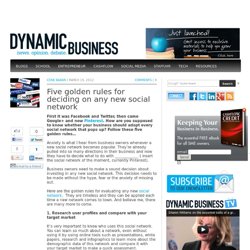
Social Media Fitness – Fat Burning and Tribe Development. Welcome to the second installment of Social Media Fitness – Zone Training: Fat Burning and Tribe Development.
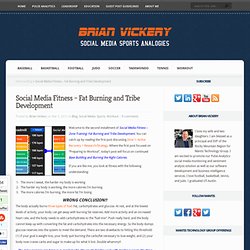
You can catch up by reading the first post discussing Zone 1: Active Recovery = Research/Strategy. Where the first post focused on “Preparing to Workout”, today’s post will focus on continued Base Building and Burning the Right Calories. If you are like me, you look at fitness with the following understanding: The more I sweat, the harder my body is workingThe harder my body is working, the more calories I’m burningThe more calories I’m burning, the more fat I’m losing The body actually burns three types of fuel: Fat, carbohydrates and glucose. Social Media Fitness – Base Building. I recently decided to take a more scientific approach to my fitness.
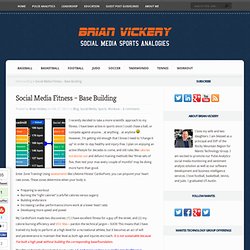
I have been active in sports since I could chase a ball, or compete against anyone…at anything…at anytime . However, I’m getting old enough that I know I need to “change it up” in order to stay healthy and injury-free. I plan on enjoying an active lifestyle for decades to come, and old rules like calories in/calories out and defunct training methods like “three sets of five, then test your max every couple of months” may be doing more harm than good. Enter Zone Training! Preparing to workoutBurning the “right calories” (carb/fat calories versus sugars)Building enduranceIncreasing cardiac performance (more work at a lower heart rate)Developing more speed and power. Social Media Fitness – Anaerobic Endurance and Content Creation. Welcome to the fourth installment of Social Media Fitness – Zone Training: Anaerobic Endurance and Content Creation.
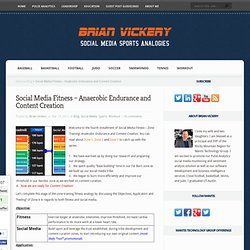
You can read about Zone 1, Zone 2 and Zone 3 to catch up with the series. We have warmed up by doing our research and preparing our strategy.We spent quality “base building” time in our Fat Burn zone as we built up our social media tribe.We began to burn more efficiently and improve our threshold in our Aerobic zone as we worked on content curation.Now we are ready for Content Creation! Let’s complete this stage of the zone training fitness analogy by discussing the Objectives, Application and “Feeling” of Zone 4 in regards to both fitness and social media. Objective: Application: Feeling: Front foot consulting. The Attention Economy: An Overview. Written by Alex Iskold and edited by Richard MacManus It is no secret that we live in an information overload age.
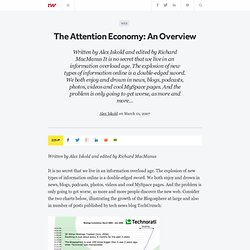
The explosion of new types of information online is a double-edged sword. We both enjoy and drown in news, blogs, podcasts, photos, videos and cool MySpace pages. The Semantic Economy. We’ve recently seen Facebook go public with a $100 billion valuation and General Motors, formerly the world’s biggest company, go effectively bankrupt and need to be bailed out by the US government.
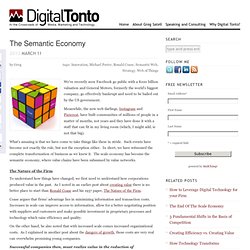
Meanwhile, the new web darlings, Instagram and Pinterest, have built communities of millions of people in a matter of months, not years and they have done it with a staff that can fit in my living room (which, I might add, is not that big). What’s amazing is that we have come to take things like these in stride. Such events have become not exactly the rule, but not the exception either.
In short, we have witnessed the complete transformation of business as we knew it. The scale economy has become the semantic economy, where value chains have been subsumed by value networks. (13) Ogilvy ChatThreads Social Media Sales Impact Study 2011. Be Square: Social Squared, That Is. At the Stanford Center for Social Innovation, we just concluded a conference with the State Department in preparation for the upcoming Rio 2.0 conference (Rio+2.0: Bridging Connection Technologies and Sustainable Development).

The focus of the conference was on the role of technology/connectivity to drive social change. As I was listening to the panels surrounded by global social innovators, the multiple meaning of the word “social” struck me. What does it mean to live in a “social” world in 2012? On one end the social spectrum, we have the version best expressed in a New York Times op ed written by Thomas Friedman on the revolution occurring in Silicon Valley. Friedman first notes, “Silicon Valley is being transformed by another technology revolution — one that is taking the world from connected to hyperconnected and individuals from empowered to superempowered. “S, he says, is for speed — everything is now happening faster.
O, he says, stands for open. (2) Altimeter Report: Making The Business Case for Enterprise Social Ne... Analysis: Social networking gets down to business - 23 Feb 2012. Big technology vendors such as IBM and Microsoft are increasingly offering social networking products that aim to help companies integrate the benefits of social media into existing business software.

However, does this mean that companies will finally begin taking the idea of social business seriously? The predictions from industry watchers indicate that is indeed the case. According to figures from Forrester Research, for example, the market for social networking platforms will grow at a compound annual growth rate of 61 per cent to $6.4bn (£4bn) by 2016.
While Gartner analyst Jeffrey Mann believes that there is a clear increase in the uptake of social business platforms by many companies, he also thinks that the rate of adoption varies between industry sectors and the type of customer that the business serves. “It depends on what industry the business is focused on. Employees at the forefront “There has been a recent shift from a management perspective on social business platforms. What Not To Leave Out Of Your Social Business Strategy. It’s been gratifying to spend the last month looking at social business success stories and documenting their progress and the lessons learned. We’ve come a long way: The maturity of the industry and our collective understanding of how to successfully transform our organizations by adapting the ideas and tools of social media to the workplace is currently at an all time high.
In the last several years, many companies have begun long term strategic planning that maps out the changes they need to make in terms of structure and process to become a fully social enterprise. In recent months, I’ve posted updated views on how to go about social business transformation using strategy as driving force to achieve cultural, organizational, and operational change. The Social Corp - How to Guide Your Customer’s Journey Through the 6 Points of Content. UM - Wave 6. The CLOUDFinance Daily. Financial advisor social media and training. Social Media Marketing Solutions for Financial Services Firms. 5 Ways to Get Your Entire Company On Board With Social Media. Is everyone supporting social media at your company?
Are you struggling to get the support you need? And although there are many reasons why social media campaigns fail, far and away one of the biggest reasons for failure is the lack of top-to-bottom “buy-in” from all employees in a company. In some cases, the CEO thinks the idea is frivolous. In others, management has their doubts . And in a large majority of companies, employees have no understanding of what social media is, what it does and how they can play a role in its success. Copy of 2012 Content Calendar Planning Template. How to Develop a Social Media Content Strategy. Do you have a social media strategy? Does it involve content? Should it? The other day I drove past a local convenience store that makes most of its profit from beer, Slush Puppies and beef jerky (not that there’s anything wrong with that). A big sign out front asked passers-by to Like them on Facebook. “It’s official,” I thought. Unfortunately, few businesses actually have a strategy for their Facebook page, or for the rest of their social media activity.
If your social media engagement is reactive rather than proactive, it’s time to step back, take a deep breath and develop a content strategy that will engage your community. A content strategy doesn’t end with good signage. Web Strategy by Jeremiah Owyang. By Jeremiah Owyang, from Silicon Valley In many respects, Silicon Valley sits atop the world. Its growth and influence has made it the globe’s top location for innovation, STEM jobs, IT patents, venture capital funding, and Internet and software growth, and Unicorn startups galore. And yet there’s also been a shift in the Valley’s culture. Growing social and economic rifts have bred fraud, anger and protests.
Where housing isn’t in high demand, neighborhoods lay abandoned.